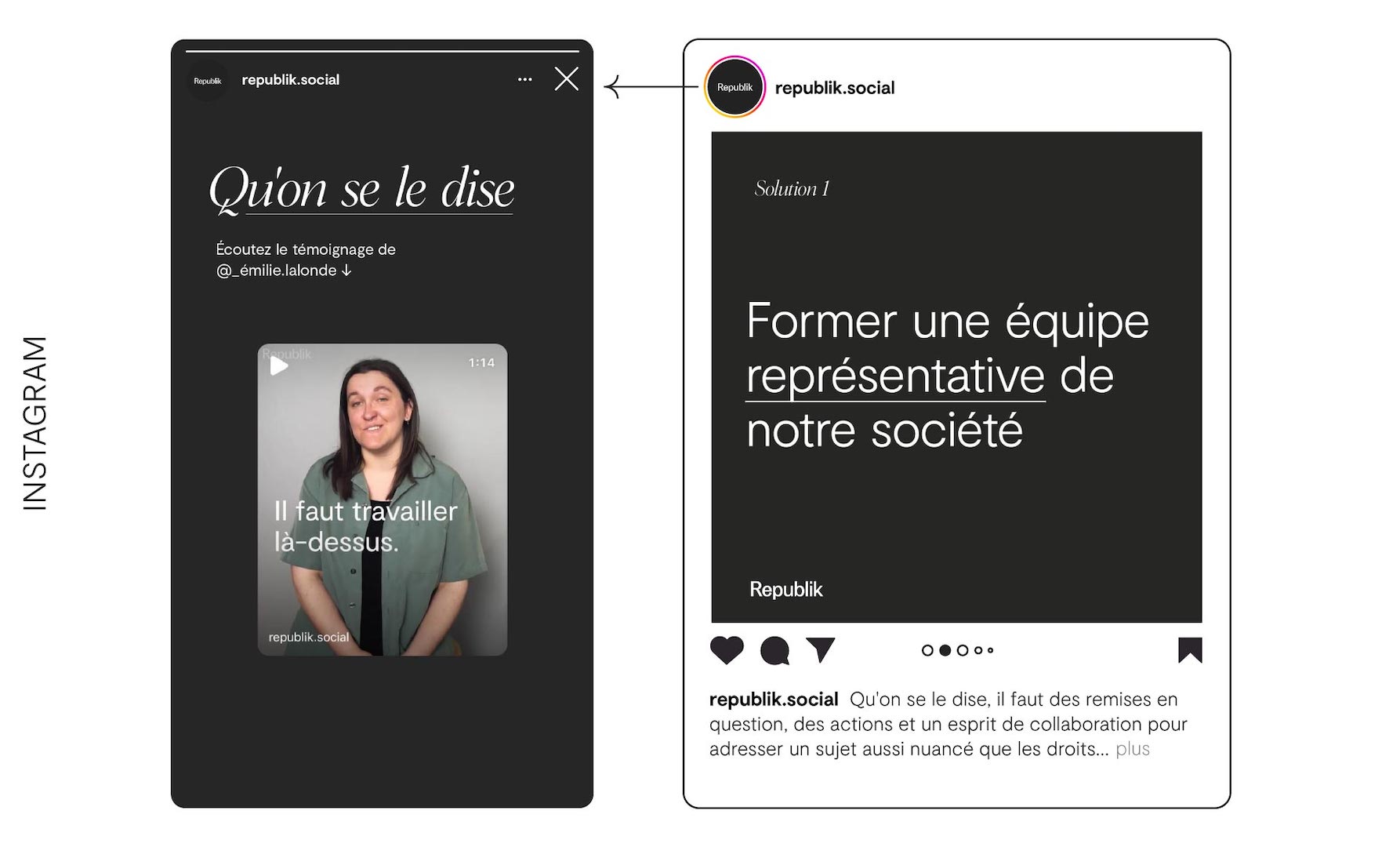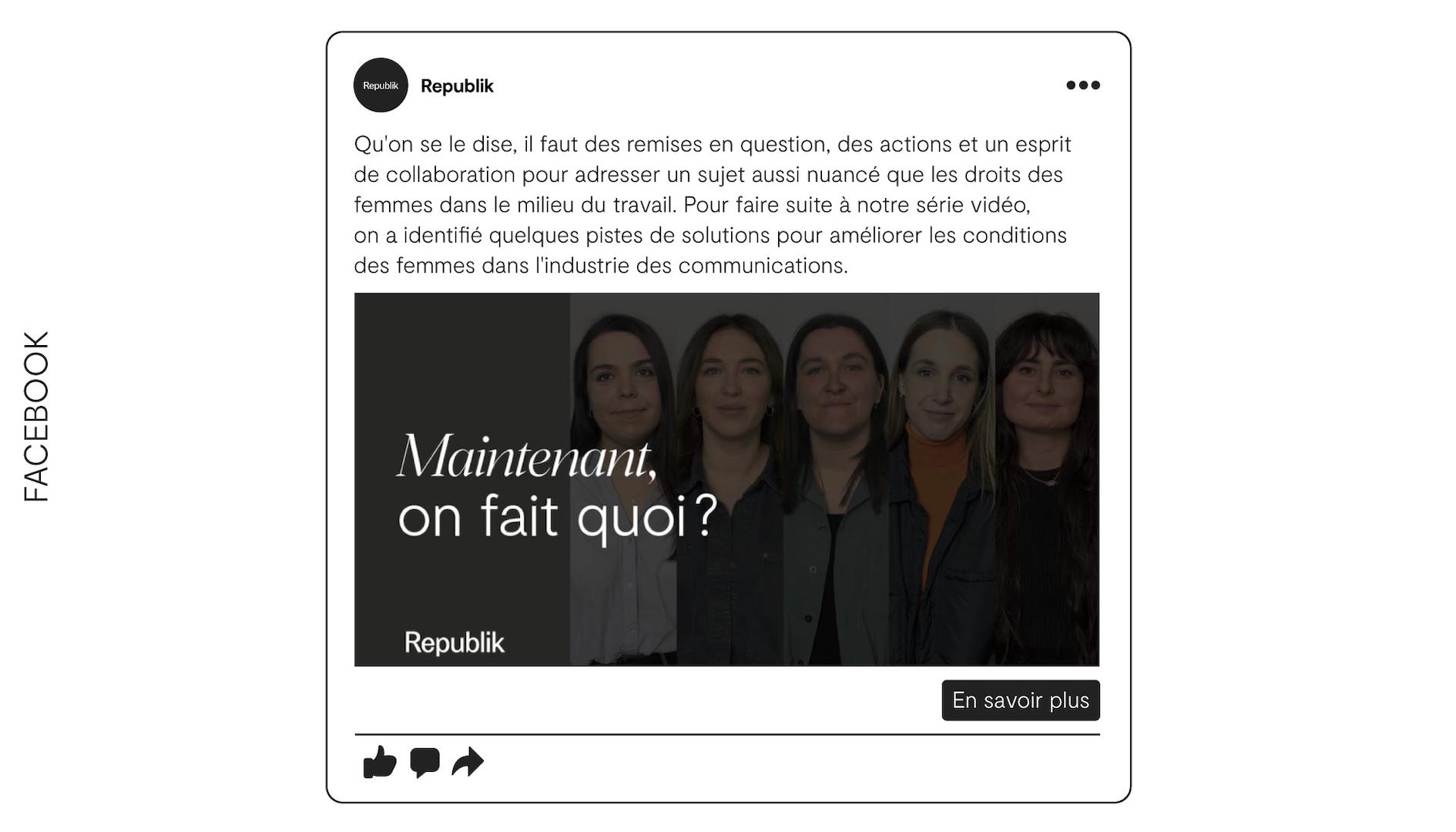
How to create inclusively and avoid the pitfalls of sensationalism with sensitivity?

How to create social capital is a series of articles that aims to make social and environmental impact in business more accessible. Through their texts, Republik specialists, a social impact creative agency, address topics pertaining to impact, content and branding.
At Republik, we believe that actions speak louder than slogans. Before even thinking about impact communication, brands need to think about impact itself: what positive effect they may have on society and our planet. Otherwise, they risk falling into one of the many pitfalls of impact communication. By developing a narrative around concrete actions, we are better able to speak our truth.
You need to be able to communicate meaningful facts and clear targets on the right social platforms, those that will reach your community. If you have implemented concrete initiatives to better society, the environment, your employees’ or stakeholder’s conditions, the world wants to hear about them!
Keep in mind that this is not a reason to share identical content on several social networks. You can use the same impact message as a starting point, but it is important to adapt said content to respect the codes of the platform on which it will be published. My goal is to help you explore the subtleties of each social network by analyzing how a video series about social impact, imagined by Republik, was adapted and shared on several of them.
We believe good social impact content has change at its heart. Whether its goal is to give its audience a new perspective, to further the discussion around major debates, to tackle uncomfortable issues or to raise awareness, social impact content is all about favouring positive change.
Most importantly, social impact content must be supported by concrete actions taken by the organizations that created it.
Last spring, Republik launched a video series called “Let’s Face It” (Qu’on se le dise). Throughout the month of March, members of our team were given the floor to discuss the representation, equity and progress of women in communications, and more specifically, within our agency.
To maximize its visibility, this social impact video series was adapted for several social platforms on which Republik already had an established community. To better understand how to use social media to the advantage of your impact communication, we thought we’d use this example to explore the many facets of each platform.
Social platforms must be thought of as an ecosystem. Each platform has its own codes, and the potential to reach a segment of the target audience that we want to address. Defining a strategy for each of them requires a deep understanding of their inner workings. Here is what can be said for the most popular social networks:
To make it on Tiktok, you have to master the art of surfing on existing trends and dare to create new ones! With its logo representing a musical note, this platform is all about entertainment and letting your imagination run wild. It’s the ideal place to offer authentic, human and trendy content: we want to avoid sharing an advertising video for our brand here. The majority of adult users in Canada are people who identify as women between the ages of 18 and 241.

On Tiktok, the “Let’s Face It” videos generated potential recruitment leads and sparked important conversations around women’s working conditions in our industry, especially among people ages 18–24.
We often scroll through our Instagram feed without much thought. To inspire people through eye-catching content, we have to tell a story beyond promoting a product or service. What’s more, we must do so with attractive and impactful visuals because you only have a few seconds to catch someone’s eye before they scroll to the next post on their news feed. This platform mainly targets millennials and people who identify as women.

First we shared the “Let’s Face It” videos on our Instagram feed and stories, one person at a time. Then, we created a carousel that brings together five solutions identified by our team to improve conditions for women in the communications industry.
This social platform caters to the widest spectrum of audiences, but also the biggest variety of formats. For example, you can create a Facebook page to build brand equity, inform and educate your target audience, but most importantly, to interact with a community. In Quebec, we generally talk to an audience that mostly identifies as female, aged 25 to 342, but we’ve noticed the users’ average age going up, year after year.

In order to further our discussion on women in marketing, we wrote a blog post inspired by the “Let’s Face It” series that details the initiatives we have put in place at Republik, and the actions we aim to take in the near future, to improve women’s conditions in our industry. Facebook being a platform of choice for sharing links, it was only natural to use the article to highlight our initiative.
This is the place to showcase your stakeholders. Just from the term “stakeholders”, we understand that LinkedIn is a platform that targets professionals, partners and business people in the industry. This social platform allows you to display your know-how, your soft skills and your business intelligence: it is mainly aimed at expert content. The platform allows you to attract new talent, potential partners and generate business opportunities. In Canada, there are close to 20 million active users, mainly between the ages of 25 and 34.

On LinkedIn, a powerful quote from the speaker was used for the cover that precedes her video. Since it’s a networking platform, we tagged the employee featured in the caption as well as including her role at Republik. “Discover Ariane’s vision…” as a call to action allows us to further personalize the content.
Unlike other platforms that rely heavily on images, YouTube focuses almost exclusively on video content. The possibilities in terms of animated content are endless: you can offer informative, educational, emotional, functional or even incentive content, as long as it meets the needs of your target audience. In fact, it is the most consulted website3, after Google. A YouTube channel can thus become an excellent source of qualified traffic. The platform’s search engine will suggest your videos to people who are interested in content, products or services similar to yours. This makes it easier to capture their attention and eventually build an engaged community on the platform. The most active audience on the platform is between 18 and 24 years old4.
Twitter is a news-driven platform. It is mostly dependent on the media, which makes it a great platform for brand PR. It can be used to promote corporate announcements and to curate well-crafted news stories that are aligned with our values and actions. Beware: Twitter content has a very short life span. Here, we do not necessarily aim at creating original content. On this platform, we rely more on proactive community management to grow. The focus is on the media, influencers, journalists, decision makers and the business ecosystem.
Pinterest is a platform where people search for new ideas. Original content should obviously inspire, but also pique the user’s curiosity so that they want to discover more. In addition to being an endless source of inspiration, it is above all a search engine and a platform of choice to generate traffic to your site. Again, the platform’s audience mostly identifies as women and is between 25 and 34 years old.
First and foremost, you need a tangible commitment to put forward. When it comes to social and environmental impact, your communication needs to be supported by concrete actions. Then, you can use this content as a starting point to share different variations of it on your social networks.
A message must remain consistent from one platform to the next while respecting each social media’s codes. Once posted, study your content’s performance and make sure to learn as you go, so you can better adapt your content for the future.